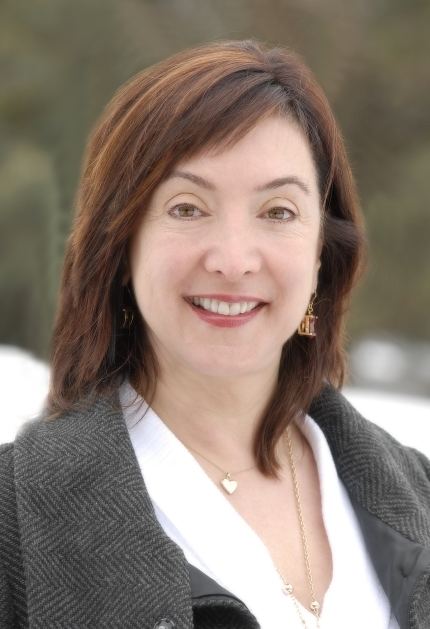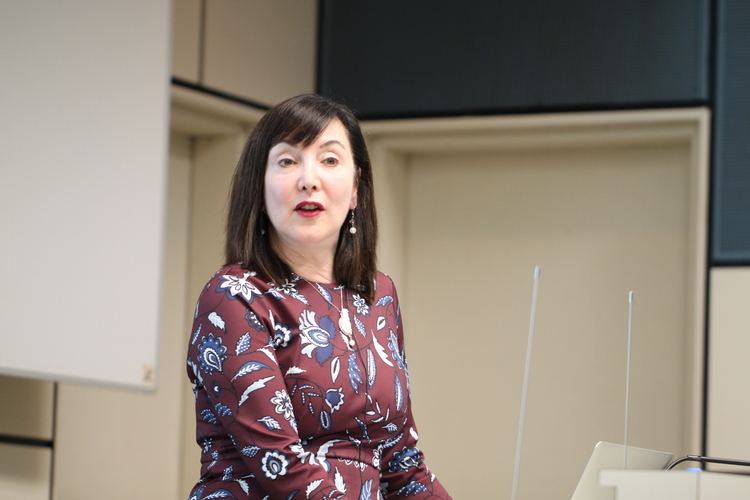Name Laura-Ann Petitto Role Neuroscientist | ||
 | ||
Residence Washington, D.C., United States Awards Guggenheim Fellowship for Natural Sciences, US & Canada | ||
Dr laura ann petitto a new lens
Laura-Ann Petitto (born c. 1954) is a cognitive neuroscientist and a developmental cognitive neuroscientist, known for her discoveries involving the language capacity of chimpanzees, the biological bases of language in humans, especially early language acquisition (be it language on the hands in sign language or the tongue in oral language), and bilingualism and the bilingual brain. She is also known for her role in the creation of the new scientific discipline, called educational neuroscience. She is currently a professor in the department of psychology at Gallaudet University, and an affiliated professor in the department of psychology at Georgetown University. Petitto is also the science director of Gallaudet University's branch of the National Science Foundation's Visual Language and Visual Learning Center.
Contents
- Dr laura ann petitto a new lens
- Vl2 introduction dr laura ann petitto
- Education
- Scientific contributions
- Early research
- Current research
- Research awards
- References

Vl2 introduction dr laura ann petitto
Education
Petitto received her Bachelor of Science degree in 1975 from Ramapo College of New Jersey while taking undergraduate classes and conducting cross-species language research with the chimpanzee "Nim Chimpsky" at Columbia University (New York City, New York). Petitto then conducted psycholinguistic research on American Sign Language (ASL) in the laboratory of Dr. Ursula Bellugi at The Salk Institute for Biological Studies (La Jolla, California), along with Linguist, Edward Klima, of the University of California, San Diego, where Petitto began graduate study in the Department of Linguistics (1976–1977). Petitto continued graduate study at New York University (Master's degree, 1978, specializing in Rehabilitative Counseling Psychology and Deafness, 1977–1978). Petitto then researched the phonological structure of ASL in the "The Linguistics Research Laboratory" of Dr. William Stokoe at Gallaudet University in Washington, D.C. (1978–1979). In 1979, Petitto began graduate study at Harvard University (Department of Human Development and Psychology), with Drs. Roger Brown (primary Graduate Advisor) and Courtney Cazden (co-Advisor), receiving her Masters in 1981 and her Ed.D. degree in March, 1984. Leaving Harvard in Fall, 1983, to take up her first faculty appointment at McGill University (Montreal, Quebec, Canada), Petitto won a John D. and Catherine T. MacArthur Foundation Postdoctoral Fellowship (to study with Dr. Ursula Bellugi and Dr. Elizabeth Bates).
Scientific contributions

Petitto's research and discoveries span several scientific disciplines. Her early work with Nim Chimpsky and her later work with humans, encompasses anthropology, comparative ethology, evolutionary biology, cognitive neuroscience, cognitive science, theoretical linguistics, philosophy, psychology, psycholinguistics, language acquisition, child development, evolutionary psychology, deaf studies, and bilingualism. Her overall discoveries involve:


Petitto had a role in the creation of a new scientific discipline that she and her colleagues have termed Educational Neuroscience, involving the marriage of basic scientific discoveries about the developing brain/child with its principled application to solving core problems in the education of young children. Taken together, her scientific writings have offered testable hypotheses and theory regarding the neural basis for the brain's specialization for human language, and show how it is possible for very young babies to acquire language.
Early research

Beginning in 1973 in the Department of Psychology at Columbia University, Petitto attempted to teach sign language to a baby chimpanzee ("Project Nim Chimpsky," named after Noam Chomsky, with Professors Herbert Terrace and Thomas Bever). Petitto had a leading role on Project Nim Chimpsky as the "Primary Sign Language Teacher", "Project Coordinator", and primary "Surrogate Mother". Despite the dangers of living with a chimpanzee, Petitto lived with and cared for Nim as a child in an attempt to create a natural language, cognitive, and highly caring and rich social environment, mirroring that of a human child. Most of the chimp's scientific training and accomplishments were achieved during Petitto's 4-year tenure on the Project as Nim's teacher and caretaker. She and her colleagues have authored several of the world's seminal scientific papers on the question of language in chimpanzees, including now classic articles on the similarities and differences between the ape and human mind.
After her undergraduate work with Nim Chimpsky, Petitto went on to make discoveries about the linguistic structure, acquisition, and representation in the brain of the world's natural sign languages, especially American Sign Language (ASL). Using sign languages as a new "microscope" to discover the central/universal properties of human language in the brain (those that are distinct from the modality of language transmission and reception), Petitto focused on the following lines of research:
Petitto's research has contributed to the body of knowledge establishing that the sign languages of Deaf people around the world are real languages with the full expressive capacity as oral languages. Petitto and colleagues were also the first to study experimentally the validity of a widely used educational practice with Deaf children in the 1970s, whereupon teachers (typically hearing) used parts of ASL signs and linguistic structure simultaneously while speaking English in the classroom, called "Simultaneous Communication" (or "Simcom"). The Petitto team's experimental study of Simcom with Deaf children demonstrated empirically that it was highly impoverished at representing either ASL or English (and, in turn, was a non-optimal teaching method), and instead supported the use of a natural language with Deaf children from early life (such as ASL), which would best provide a solid linguistic foundation upon which to learn other languages (such as English) and advanced the idea that Deaf Education would be best to move closer to a full bilingual/bicultural educational model. This research had lasting implications for subsequent Deaf Education policy and practice.
Current research
Petitto's more recent studies involve the use of a combination of three disciplines:
Since 2000, Petitto and her laboratory team are known for discovering that young bilingual children are not harmed, delayed, or confused by early dual language exposure. These children, not only achieve their language milestones (in each language) on the same timetable as monolinguals, they demonstrate the same semantic and conceptual development as monolinguals. Petitto and her team have also identified the mechanisms that make possible the human infant's early capacity to phonetically discriminate (segment and categorize) the constantly varying linguistic stream around them. Petitto has identified fundamental processes that underlie human reading and spelling in all language users and found evidence for select reading advantages in young bilingual children as compared to matched monolingual peers, termed the "bilingual reading advantage". They have further discovered surprising ways in which bilingual schooling can ameliorate the deleterious effects of low SES They are also among the first group of researchers to compare directly adult bilingual and monolingual brains and what happens when the adult brain learns two artificial languages as a second language.
Petitto and her team also conduct genes, behavior, and brain studies of how extensive training (expertise) in one domain of knowledge impacts or "transfers" to other domains of knowledge (and the extent of this transfer). For example, Petitto studies how extensive training in the arts impacts a young child's acquisition of other knowledge, a question vital to educational policy-makers with limited budgets. She and her team also study expert performing artists (e.g., dancers) and the extent to which "expertise" of this type may transfer to "near" and "far" domains of knowledge.
Research awards
Petitto is the recipient of over twenty international prizes and awards including,
